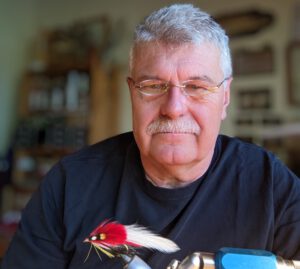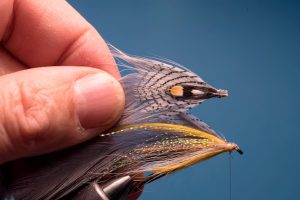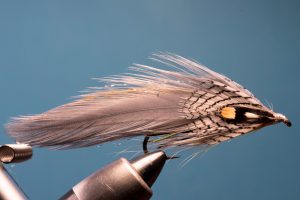
Tying at the Bending Feathers: Gray Ghost and Co.
For many years, I have had a weakness for classic streamers from New England. With their sometimes colorful forms and jungle cock feathers as cheeks or eyes, they somewhat resemble the elaborate, traditional featherwing salmon flies. A pioneer of this style of tying was the hat maker, Carrie Stevens. In the first half of the last century, she lived with her husband Wally Stevens, a professional fishing guide, in the Rangely Lake region of Maine which, then as now, was a popular fishing and hunting area for the people from the big cities on the east coast of the USA looking for recreation. Her best-known creation was surely the gray ghost, a streamer which may well be found in many of today’s fly boxes. The question does arise if these patterns are still properly tied. When tying, Mrs. Stevens liked to use a special and defining trick. She first glued the main wing and the overlying shoulder wing together and then tied this completed module not on top of, but on the side of the hook shank. The result was a very streamlined pattern producing a successful imitation of a small, slender fish.
Many fly tyers have adopted this tying style, developed it further, and produced their own creations. The good part is that, even today, we all can develop our own versions. Traditional, natural materials can be enhanced with modern artificial materials. Some integrated flash-fibers look good in the water and produce attractive reflected light. Whether or not the appearance of the streamer is now imitative or tends toward being a colorful attractor, the fish will find it interesting. I had my first special success with such a fly about 30 years ago. On the Lough Mask in western Ireland, I trolled for the first time a self-tied variation of the grey ghost behind a boat with a slow-running outboard motor. Eventually a strike jerked the rod and, after a considerable fight, I landed a 3 kilogram brown trout. It was the second largest wild trout I had ever caught. I saw this as a very successful introduction to this type of streamer.
In tying this pattern, you can match existing flies or let your imagination have free reign. There is plenty of opportunity to experiment and a lot of fun in tying is guaranteed. During the Bending Feathers, I will gladly show you various examples of the tying methods of Carrie Stevens.
See you soon,
Hans Eiber



